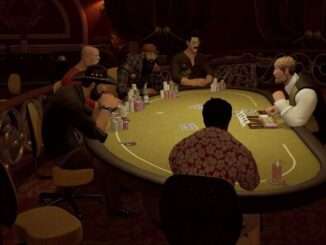
Prominence Poker Guides:
- Types of Players.
- Playing Like a Rock.
Why Play Poker?
Poker is fun. It’s a game primarily of skill, where over a long enough period the best players will always be at the top and the weakest players at the bottom. It’s also a game of incomplete information where over a small number of hands the results are dominated by chance and luck of the draw. It’s a game where you don’t just learn how to play the cards well, you also have to learn to read people well and win a battle of wits with the people sat around the table. It’s one of those games where you can very quickly reach a level of competence at which the game is enjoyable, but can also play for decades without running out of things to improve on. It’s also a great game to develop patience, composure under pressure, and problem-solving skills.
Don’t I Have to Be Some Kind of Nerdy Maths Buff to Do Well at Poker?
No, you really don’t. Having some basic maths skills is really useful, and being able to count up to 15 is definitely essential, but being able to work out whether you’re calling a bet that’s greater or equal to 38% of the pot? This kind of precision in your play is only relevant at high levels, and even then, it will be less important than accurately reading the types of player you’re playing and how accurately you can guess the strength of their hands.
The Goal
Importantly, the goal of playing poker is not to win the most hands, it’s to win the most money/chips. You can win only a small handful of hands and fold all the others and still be very profitable, provided you learn techniques of making other players put in lots of chips on your good hands, and making sure you invest as little as possible in the hands you end up folding.
The Basics
Typically, between 2 and 9 players are found around an NLH table. Prominence only supports tables of up to 6 players. A ranked play tournament will always have six players in it, each player starting with the same number of chips, and is basically an elimination event with one winner when all other players are “busted” (run out of chips). A casual play game is what’s also known as a ring game or cash game, where you bring your actual virtual chips to the table, and take away whatever you leave with. If you run out of chips, you can rebuy if you have them in your bankroll rather than being eliminated, and you can leave whenever you like. These guides will all be based on ring games rather than tournaments unless there’s a specific request in the comments for tournament guides.
Play consists of making bets of a certain number of chips, until everyone has either “folded” (decided they don’t have a good enough hand to pay chips with), or until everyone has paid the same amount in that betting round. Play proceeds around the table in a clockwise direction, starting with the player after the big blind (more on this later) before the “flop” (The first three community cards placed on the table that are shared by every player) and starting on the small blind after the flop. There is a maximum of four betting rounds, after which any players still playing compare their cards to see who has the best hand. This is called the showdown, and each player’s final hand is the best that can be made out of their two “hole cards” (dealt at the beginning of each hand, face down, known only to the player) and the five community cards face up on the table. The winner takes all the money in the “pot” (basically where it all goes from everyone’s bets), and the hand is finished. Once a hand has completed, the button (again, more on this later), small blind and big blind all move exactly one position clockwise, and a new hand begins.
The Blinds
In each hand, before any player is allowed to see the first three flop cards, they must first pay a small number of chips. This is known as the “blind”, and on prominence ring games is 1% of the “buy in” (the amount of chips you have to bring to the table to play). On a 10k table the blind is therefore 100 chips. On each hand, there is a big blind who is forced to pay the blind, and a small blind to his right who has to pay half of it, and can choose whether or not to pay the other half. This system exists to prevent players deciding that the best way to win is not to play any hole cards other than extremely strong hands, as steadily they are forced to slowly bleed chips to other players.
Playing Hands – Pre-Flop
Assuming you aren’t a small or big blind, when play reaches you, you can choose to “fold” your cards (give them back to the dealer, face down, and remove yourself from the hand), pay the blind, or raise to a larger amount – perhaps you have great cards, and you want your opponents to pay more to play, in NLH you can raise as much as you like (hence the “no limit”). If someone has raised already, then you need to pay this amount rather than the blind, and the small and big blinds must pay the difference as well (if the big blind is 100, and someone has raised to 400, the big blind still owes 300 before he gets to see the flop).
Playing Hands – Post-Flop
Once everyone has either paid the same amount as each other or folded their cards, three cards are drawn from the deck and placed face up on the table (the “flop”). At this point, all remaining players now have a full five card hand, and have some idea how strong their hand is looking from this point onwards. No-one has to pay any money from now on unless a player voluntarily bets. There is now another betting round starting with the small blind, and you can either “check” (basically staying in the hand, but not placing any money in the pot), bet, or fold. Once someone has bet, the choices are either to “call” (match the bettor’s bet), “raise” (put the money in and an extra amount, from the same amount of money again up to all of your chips), or fold.
After this betting round, another card is drawn (known as the “turn”), and the third betting round begins. Then the last card is drawn (known as the “river”), and a final betting round takes place, followed by the showdown where the players all show their cards (starting with the last person to bet or raise on the river, or starting with the small blind if everyone checks the river), and the best hand wins the pot.
Aces can represent a “1” or “1 above a King” depending on what’s best, and there’s a full ranking list of completed hands that you can load at any time while you’re at a table until you know them. I’ve taken the liberty of putting them all below and % frequency at which they happen (assuming everyone plays every hand their dealt all the way to the showdown):
High Card: No pair can be made from any of the 7 cards (your two and the five community cards). The highest value card out of the hole cards of the remaining players wins. (17.4%)
Pair: A single matched pair can be made where the value (but not suit) of the cards is the same. The highest value pair wins, using the highest non-paired card as a tiebreaker. (43.8%)
Two pair: Two matched pairs can be made. In this the highest top pair wins, followed by the highest second pair if more than one person has the same top pair. (23.5%)
Trips/Three of a kind: Three cards of the same value can be made from the 7 cards. (4.83%)
Straight: Using the 7 cards available, a player can make a consecutive string of 5 cards in ascending/descending value, like 4-5-6-7-8 or T(ten)-J-Q-K-A. Suit not important. (4.62%)
Flush: Using the 7 cards available, a player can put a hand together of 5 cards of the same suit. If more than one player has a flush, the highest non-community card wins. (3.03%)
Full House: A player can put together a three of a kind and a pair out of 5 cards. (2.60%)
Four of a kind: A player can put together all four cards in a deck of the same value in their 5-card hand. (0.17%)
Straight flush: The same as a straight, but where all sequential cards must also be of the same suit. A straight flush that runs T-J-Q-K-A is known as a Royal flush, and is the best possible hand. (0.03%)



How do you leave the Table ?